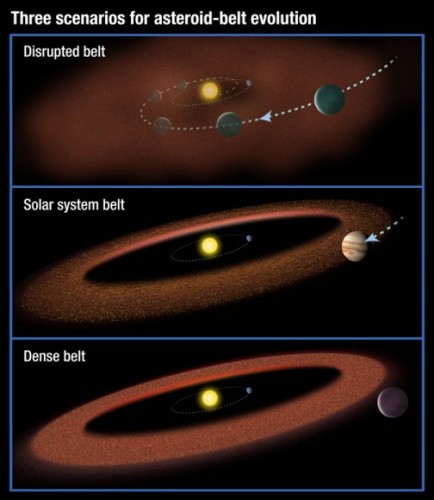The researchers came to this conclusion after creating a series of theoretical models based on observations of the debris disks surrounding other stars, as well as the Jupiter-like planets discovered so far.

Asteroids can be a means of exterminating life, scarring a planet's surface with fire and molten rock, but asteroids can also help seed a planet with the right ingredients to create the infrastructure for life and encourage life to develop more complex survival strategies.
As with everything, it's all a question of dosage. Too many asteroids and we get cosmic range, deadly fire meteors from the sky. Too few asteroids and complex life may not get the materials they need. Life does not get a chance to occasionally mix and develop into more complex formations.
These conclusions stem from the research of Rebecca Martin, a NASA Sagan Fellow at the University of Colombo in Boulder and Mario Livio of the Space Telescope Science Center in Baltimore, Maryland (formerly a sought-after lecturer at the Technion, AB). The researchers created a series of theoretical models based on observations of the debris disks surrounding other stars, as well as the Jupiter-like planets discovered so far.
They found that only a fraction of a percent of solar systems contain giant planets in the right position that helps create an asteroid belt of the right size. In fact, our solar system seems to be a rare case when it comes to the right size of the asteroid belt.
"Our research has shown that only a handful of solar systems observed so far have planets in the right place to create an asteroid belt of the right size, giving rise to the potential for life on the nearby rocky planets." says Martin, the paper's lead researcher. "Our study hypothesizes that our solar system may be quite special."
According to her there are three possible models of the creation of asteroid belts in other solar systems.
* Jupiter-sized worlds move slowly inward, disrupting the asteroid belt before it can form. All potential asteroids fall into the planet or are blown into deep space. A potential Earth-like world is drained of its chemicals and experiences catastrophic damage during this transition. Because of this complex life cannot arise. it's bad.
*No Jupiter-type planets form in the system, which allows the solar system to produce a massive asteroid belt. The materials from this vast and dense belt could over-punish the Earth-like worlds and not give life a chance. That's not good either.
* Jupiter-sized worlds form in the outer solar system, and they move only slightly, which prevents the formation of too large an asteroid belt. There are still enough asteroids to seed Earthly worlds with chemicals and encourage evolution, but not enough to set back progress. And that's us.
To reach this conclusion, Martin and Livio modeled protoplanetary disks around several stars, then observed what might happen in a variety of combinations of Jupiter-like planets. They compared their models to 90 protoplanetary disks discovered so far by NASA's Spitzer Space Telescope, and to 520 giant planets discovered around other stars.
So far, only 4% of the systems the researchers have looked at contain the right combination of a compact asteroid belt and a nearby Jupiter-like planet. This gives researchers a specific configuration of the asteroid belt and arrangement of the planets to search for when seeking to find worlds that could contain complexity.
For the news in Universe Today

3 תגובות
A very witty claim, but not scientifically proven.
Although from a probabilistic point of view they are probably right, still under certain conditions it can happen/not happen contrary to predictions.
white candle,
Don't forget that there are other important factors in the creation of life, and there may be a number of factors that we do not yet recognize as important to it. Despite everything, we don't exactly know how Christians live in God's Word and in general.
Another important factor is that the planet will be in the "habitable zone" relative to the star, neither too cold nor too hot to allow liquid water to exist.
But I share your optimism, because our knowledge (and sometimes lack of knowledge) is based only on the only form of life known to us, and it is possible that life in other places is based on other conditions and we are the exceptions...
For example the moons of Jupiter. In Europa, the data show the possibility that there is an ocean under the ice layer that covers the moon, even though it is very far from the sun. The heat is created by friction created by Jupiter's gravity waves.
In addition, we discover more and more extremophiles: life forms that live in extreme conditions, such as heat, cold, radiation, etc...
4% out of a sample of about 600 solar systems is about 25-20 solar systems with potential for existence
living in our immediate immediate vicinity in the galaxy.
So it must be assumed that even in this small and limited environment there are many more solar systems that have not yet been observed.
It feels like the entire galaxy is teeming with life....and very densely.